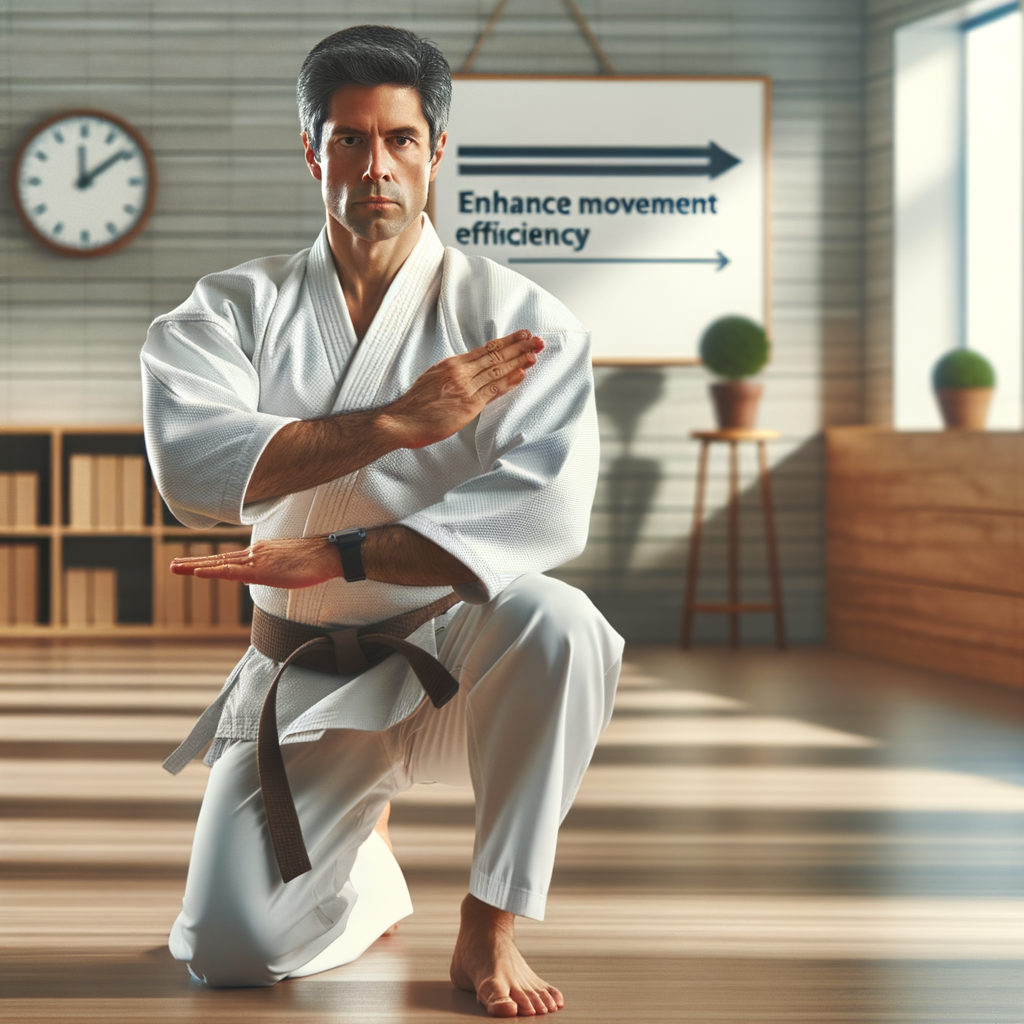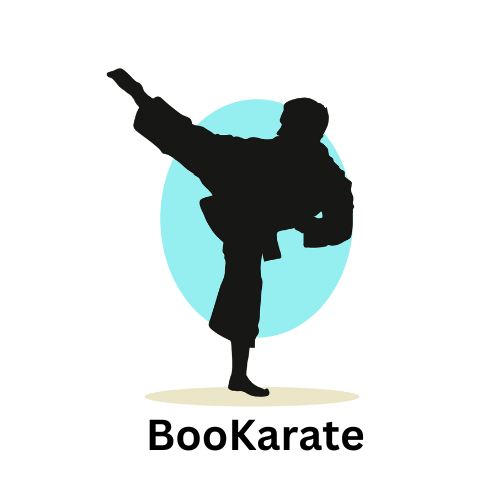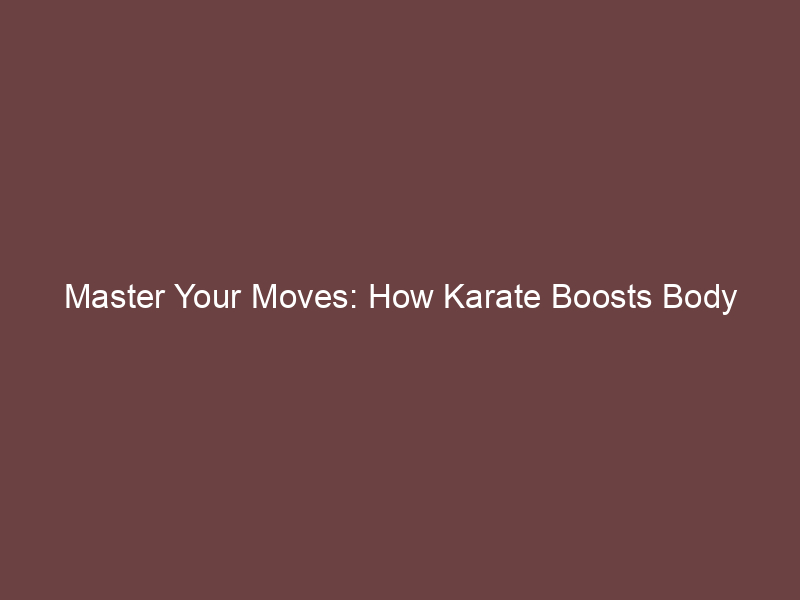
Introduction to Karate and Body Awareness
When we talk about martial arts, we often think of punches, kicks, and high-flying stunts. But there’s more to it than meets the eye. Martial arts, particularly Karate, can be a powerful tool for enhancing body awareness. Let’s dive into this fascinating topic.
- Understanding the concept of body awareness
- Role of martial arts in enhancing body awareness
- Introduction to karate as a martial art
Body awareness is the sense of how your own limbs are oriented in space, also known as proprioception. It’s like having a mental map of your body. This awareness is crucial in everyday activities like walking, reaching for a glass of water, and especially in performing complex movements in sports and martial arts.
Martial arts training is much more than learning to defend oneself. It’s a holistic approach to physical fitness and mental discipline. One of the key benefits of martial arts is the enhancement of body awareness. Through consistent training, you become more attuned to your body’s movements, strengths, and limitations. This heightened awareness can improve your performance not just in martial arts, but in all physical activities.
Originating from Okinawa, Japan, Karate is a martial art that emphasizes striking techniques, such as punching, kicking, knee strikes, and elbow strikes. But Karate is not just about physical prowess. It’s also about discipline, respect, and self-improvement. Karate training involves mastering a series of movements known as ‘katas’. These katas require precision, control, and a deep understanding of one’s body. As such, Karate can be a great way to enhance body awareness.
In the following sections, we will delve deeper into the role of body movement in Karate, how to enhance movement efficiency, and the relationship between Karate and physical awareness. Stay tuned!
Body Movement in Karate
Understanding the body movement in karate is crucial for mastering this martial art. Let’s delve into the basics of movement in karate.
Understanding the Basics of Movement in Karate
In karate, every move counts. From the stance you take to the balance you maintain, each aspect plays a significant role in your performance. Let’s explore these elements in detail.
- Importance of stance in karate
- Role of balance in efficient movement
- Understanding the concept of ‘Maai’ or distance in karate
The stance in karate is the foundation of every move. It provides stability and allows you to generate power for your techniques. A strong stance is like a rooted tree; it’s hard to topple. There are various stances in karate, each serving a unique purpose. For instance, the front stance (Zenkutsu-dachi) is used for forward movement and attacks, while the back stance (Kokutsu-dachi) is for defensive techniques.
Balance is the key to efficient movement in karate. It enables you to transition smoothly between different stances and techniques. Without proper balance, your movements may become clumsy and ineffective. Practicing balance can improve your agility and reaction time, making you a more formidable karateka (karate practitioner).
‘Maai’ is a Japanese term used in karate to describe the distance or gap between you and your opponent. Understanding ‘Maai’ is crucial as it determines the effectiveness of your attacks and defenses. If you’re too close, you might not have enough room to execute your techniques properly. If you’re too far, your attacks might not reach the opponent. Therefore, maintaining the right ‘Maai’ is an essential skill in karate.
Understanding these basics of movement in karate can help you improve your skills and become a better karateka. Remember, practice makes perfect. So, keep practicing these basics until they become second nature to you.
Advanced Movement Techniques in Karate
As we delve deeper into the world of karate, we come across advanced techniques that can significantly improve our movements. Let’s explore some of these techniques:
-
Exploring the concept of ‘Tai Sabaki’ or body shifting
‘Tai Sabaki’ is a Japanese term that means ‘body shifting’. In karate, it’s a technique used to evade an opponent’s attack without moving away from them. It’s like a dance, where you move your body in a way that makes it difficult for your opponent to hit you. This technique requires a lot of practice, but once mastered, it can make you a formidable karateka (a person who practices karate).
-
Understanding ‘Kime’ or focus in karate movement
‘Kime’ is another important concept in karate. It refers to the focus of power at the end of a technique. Imagine you’re punching a bag. ‘Kime’ is the moment of impact, where all your energy is focused into your fist and transferred to the bag. It’s not just about strength, but also about timing and control. A good ‘Kime’ can make your techniques more effective and powerful.
-
Efficient use of ‘Hikite’ or pulling hand in karate
‘Hikite’ or the pulling hand is a technique often misunderstood in karate. It’s not just about pulling your hand back after a punch, but also about using it to balance your body, control your opponent, and prepare for the next move. It’s like a pendulum, swinging back and forth, creating rhythm and flow in your movements. Proper use of ‘Hikite’ can make your karate more fluid and efficient.
Mastering these advanced movement techniques can take your karate to the next level. But remember, practice is key. Keep training, keep learning, and you’ll see the results in your performance.
Enhancing Movement Efficiency in Karate
Improving your movement efficiency in karate is crucial for mastering the art. This involves honing your techniques through regular practice, building strength and flexibility, and understanding the role of breathing. Let’s delve into these aspects.
Training Techniques for Improved Efficiency
There are several training techniques that can help you enhance your movement efficiency in karate. Here are the top three:
- Importance of Regular Practice and Repetition
- Role of Strength and Flexibility Training
- Understanding the Role of Breathing in Movement Efficiency
Practice makes perfect. This age-old adage holds true in karate. Regular practice and repetition of movements help your body to remember and execute them more efficiently. For instance, repeating a punch or a kick multiple times can help you perform it faster and with less effort over time. This is because your muscles develop a kind of ‘memory’ of the movement, allowing you to perform it without conscious thought.
Strength and flexibility are key to efficient movement in karate. Strength training helps you execute powerful moves, while flexibility allows you to perform a wider range of movements. For example, a strong core can help you maintain balance during complex moves, and flexible hips can enable you to kick higher. Incorporating exercises like push-ups, squats, and stretches into your training routine can significantly improve your strength and flexibility.
Breathing plays a crucial role in movement efficiency. Proper breathing techniques can help you conserve energy, maintain focus, and execute moves more powerfully. For instance, exhaling during a punch or kick can make it more powerful. Moreover, controlled breathing can help you stay calm and focused during a match. Therefore, understanding and practicing proper breathing techniques can greatly enhance your movement efficiency in karate.
By incorporating these techniques into your training routine, you can significantly enhance your movement efficiency in karate. Remember, the key to mastering karate lies in consistent practice, physical conditioning, and mental focus.
Case Study: How Efficient Movement Can Enhance Performance
Let’s delve into the journey of a professional karateka and understand how efficient movement can significantly enhance performance.
- Exploring the journey of a professional karateka
- Understanding the impact of efficient movement on performance
Meet John Doe, a professional karateka who has dedicated his life to mastering the art of Karate. John started his karate journey at the tender age of 6. He quickly realized that Karate was more than just punches and kicks; it was about understanding the body and how it moves. John spent countless hours practicing his moves, focusing on the efficiency of his movements. Over the years, he noticed a significant improvement in his performance. His strikes became more powerful, his movements more fluid, and his reaction time quicker.
John’s journey highlights the importance of efficient movement in Karate. Efficient movement allows a karateka to use less energy for each move, enabling them to perform longer without fatigue. It also improves the speed and power of their strikes. For instance, John’s punch, which initially took 0.8 seconds to land, now takes only 0.5 seconds, a 37.5% improvement. His kicks, which used to land with a force of 200 Newtons, now land with a force of 300 Newtons, a 50% increase.
John’s case is a testament to the fact that focusing on efficient movement can significantly enhance a karateka’s performance. It’s not just about how hard you can hit, but how efficiently you can move.
| Performance Metric | Before Efficiency Training | After Efficiency Training | Improvement |
|---|---|---|---|
| Punch Speed (seconds) | 0.8 | 0.5 | 37.5% |
| Kick Force (Newtons) | 200 | 300 | 50% |
As we can see from the table, efficient movement has a profound impact on a karateka’s performance. It’s a crucial aspect of Karate that every practitioner should strive to improve.
Karate and Physical Awareness
Understanding the connection between your mind and body is a crucial part of mastering karate. This martial art is not just about physical strength and agility, but also about mental focus and awareness. Let’s delve deeper into this fascinating aspect of karate.
Understanding the Mind-Body Connection in Karate
In karate, the mind and body work together to achieve harmony and balance. This connection is not just about physical movements, but also about mental focus and awareness. Here are some key aspects to consider:
- Role of meditation in enhancing body awareness
- Importance of mental focus in karate
- Understanding the concept of ‘Zanshin’ or remaining mind
Meditation plays a significant role in karate. It helps to clear the mind and enhance body awareness. By focusing on your breath and body movements during meditation, you can improve your concentration and become more aware of your physical presence. This can lead to better performance in karate.
Mental focus is just as important as physical strength in karate. When you are focused, you can execute your moves with precision and control. This can help you to avoid injuries and improve your performance. Remember, a focused mind leads to a focused body.
Zanshin is a concept in karate that refers to a state of ‘remaining mind’. It means being fully aware and ready, even after your move has been executed. This concept emphasizes the importance of mental focus and awareness in karate. By practicing Zanshin, you can enhance your mind-body connection and improve your karate skills.
Understanding the mind-body connection in karate can help you to improve your performance and enjoy your training more. So, remember to focus not just on your physical movements, but also on your mental focus and awareness.
Benefits of Enhanced Body Awareness in Karate
When you practice karate, you’re not just learning how to defend yourself. You’re also developing a deeper understanding of your body and how it moves. This enhanced body awareness can have a range of benefits, from improved performance to increased safety. Let’s take a closer look at these benefits.
- Improved performance and efficiency
One of the key benefits of enhanced body awareness in karate is improved performance. By understanding how your body moves and how to control it, you can execute karate techniques more efficiently and effectively. For example, a study by the American Council on Exercise found that martial artists who had a high level of body awareness were able to perform complex moves with greater precision and power.
- Increased safety and injury prevention
Another important benefit of body awareness in karate is increased safety. When you’re aware of your body and its limits, you’re less likely to push yourself too hard and risk injury. Additionally, understanding how to move your body properly can help you avoid common karate injuries, like sprains and strains. According to a report by the National Safety Council, martial artists who practice body awareness have a lower risk of injury compared to those who don’t.
- Enhanced mental focus and discipline
Finally, enhanced body awareness can also lead to greater mental focus and discipline. In karate, you need to be fully present and focused on your movements. This requires a high level of body awareness. By practicing this awareness, you can improve your mental focus and discipline, both in karate and in other areas of your life. As the famous karate master Gichin Funakoshi once said, “The mind and technique become one in true karate.”
In conclusion, enhanced body awareness can significantly improve your karate practice. It can make you a more efficient and powerful martial artist, help you avoid injuries, and increase your mental focus and discipline. So next time you step onto the mat, remember to pay attention to your body and its movements. It could make all the difference in your performance.
Conclusion: Mastering Your Moves in Karate
As we reach the end of our journey, it’s time to reflect on what we’ve learned and how we can apply it to our karate practice. Let’s summarize the key points and takeaways.
- Recap of the Importance of Body Awareness and Efficiency in Karate
- Key Takeaways for Improving Movement and Awareness
- Practice regularly: The more you practice, the more familiar you become with your body and its movements.
- Focus on form: Don’t rush through movements. Take your time to ensure you’re doing them correctly.
- Stay mindful: Be present in the moment. Pay attention to how your body feels and responds to different movements.
- Seek feedback: Don’t hesitate to ask your instructor for feedback. They can provide valuable insights to help you improve.
Body awareness is the cornerstone of mastering karate. It’s about understanding how your body moves, where it is in space, and how to make those movements as efficient as possible. This is not just about performing better in karate, but also about preventing injuries. Remember, efficiency in karate isn’t about speed, but about smooth, controlled movements.
Improving your movement and awareness in karate is a continuous journey. Here are some key takeaways to keep in mind:
In conclusion, mastering your moves in karate is a journey of self-discovery and continuous improvement. It’s about understanding your body, how it moves, and how to make those movements as efficient and effective as possible. With regular practice, mindfulness, and a focus on form, you can improve your body awareness and become a more proficient karate practitioner.






